Themed collection Editor’s Choice: Advances and New Avenues in Liquid Crystal Science

The importance of structure property relationship for the designing of biomaterials using liquid crystal elastomers
In this perspective, we presented our group’s journey to design biomaterials using LCEs and as inks for 3D printing. We addressed properties sought in a scaffold that address cells’ specific needs, and how we used the intrinsic properties of LCEs to influence on cell behavior.

Mater. Adv., 2022,3, 5725-5734
https://doi.org/10.1039/D2MA00401A
The significance of nanoparticle shape in chirality transfer to a surrounding nematic liquid crystal reporter medium
This perspective reports on recent progress toward the development of an approach to a priori predict - both chirality “strength” and efficacy of chirality transfer from a chiral nanoshape solute to an achiral nematic environment.
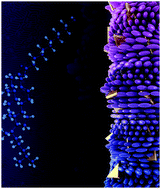
Mater. Adv., 2022,3, 3346-3354
https://doi.org/10.1039/D2MA00093H
Azobenzene isomerization in condensed matter: lessons for the design of efficient light-responsive soft-matter systems
This work reviews photoswitching of azobenzenes in soft and self-assembled materials, providing an outlook for smart soft matter design.
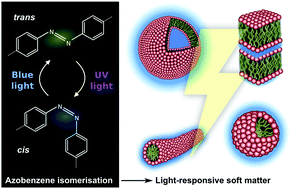
Mater. Adv., 2021,2, 4152-4164
https://doi.org/10.1039/D1MA00340B
Columnar liquid-crystalline J-aggregates based on N-core-substituted naphthalene diimides
Two approaches have been developed to prepare liquid-crystalline J-aggregates based on naphthalene diimides.

J. Mater. Chem. C, 2023,11, 10884-10892
https://doi.org/10.1039/D3TC01560B
Topological defects stabilized by a soft twist-bend dimer and quantum dots lead to a wide thermal range and ultra-fast electro-optic response in a liquid crystalline amorphous blue phase
Adding an NTB material to BPLC increases the thermal range of BPI. Further doping with QDs leads to the induction of BPIII, with a wide thermal range of 34 °C, spanning ambient and below/above ambient temperatures with enhanced display parameters.
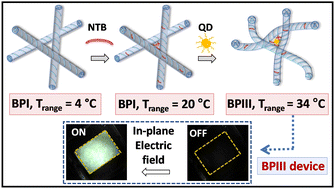
J. Mater. Chem. C, 2023,11, 9686-9694
https://doi.org/10.1039/D3TC00861D
Anisotropic sol–gel transition and morphological aspects of a hierarchical network of nematic gel and a superimposed photopolymer
The thermodynamic phase in which photopolymerisation is performed governs the morphological characteristics of a nematogen with hierarchal network feature possessing independent gelator and reactive monomer constituents.
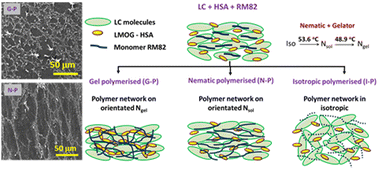
J. Mater. Chem. C, 2023,11, 7682-7696
https://doi.org/10.1039/D3TC00991B
Anti-counterfeiting holographic liquid crystal gels with color and pattern control
Optically tunable and switchable reflection grating LC gels can be used in anti-counterfeiting materials for optical security and encryption. Reflection colors and patterns appear by applying an AC field and a DC field controls the holographic color of the samples.

Mater. Adv., 2023,4, 2418-2424
https://doi.org/10.1039/D3MA00041A
Chiral amplification induced by self-assembly of different aggregation states in liquid crystal block copolymer films with chiral response
The gabs of the J-type stacking helix assembly induced by DiBTA was an order of magnitude larger than that of the H-type column assembly induced by DiBETA.
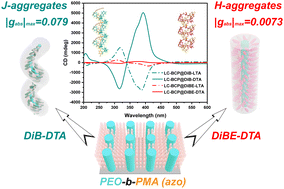
Mater. Adv., 2023,4, 2185-2191
https://doi.org/10.1039/D3MA00103B
Light-induced bi-directional switching of thermal conductivity in azobenzene-doped liquid crystal mesophases
UV-Vis light irradiation induces a fast, bidirectional switching of thermal conductivity in doped liquid crystals.
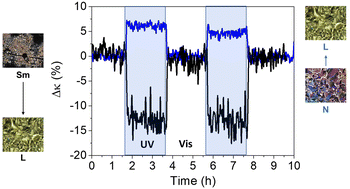
J. Mater. Chem. C, 2023,11, 4588-4594
https://doi.org/10.1039/D3TC00099K
Functional group polarity-modulated formation of liquid crystals of amphiphilic cyclodextrins
Polyesterified amphiphilic β-cyclodextrin derivatives bearing functionalized tetraethylene glycols showed excellent abilities to self-assemble into stable hexagonal columnar mesophases with 1D ion conducting channels.

J. Mater. Chem. C, 2023,11, 4153-4163
https://doi.org/10.1039/D2TC05024B
First azulene liquid crystal with de Vries behavior and a SmA re-entrant phase
Novel calamitic mesogens with an azulene core show de Vries-like properties and a SmA re-entrance phase.

Mater. Adv., 2023,4, 1306-1313
https://doi.org/10.1039/D2MA01055K
Fabrication of an anodized nanoporous aluminium (AAO/Al) transparent electrode as an ITO alternative for PDLC smart windows
An anodized nanoporous aluminium (AAO/Al) transparent electrode for energy-efficient PDLC smart windows.
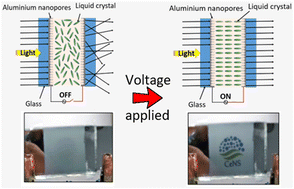
Mater. Adv., 2023,4, 923-931
https://doi.org/10.1039/D2MA01007K
Observation of helical self-assembly in cyclic triphosphazene-based columnar liquid crystals bearing chiral mesogenic units
Cyclotriphosphazene-based discotic liquid crystals are reported exhibiting helicoildal columnar arrangement and fluorescence turn-on phenomenon.

J. Mater. Chem. C, 2023,11, 1067-1075
https://doi.org/10.1039/D2TC03847A
Azobenzene-decorated cellulose nanocrystals as photo-switchable chiral solutes in nematic liquid crystals
Cellulose nanocrystals, surface-decorated with azobenzenes, are introduced as chiral solutes with molecular and morphological chirality and bestowed with the ability to photoswitch the helical pitch of induced chiral nematic liquid crystal phases.
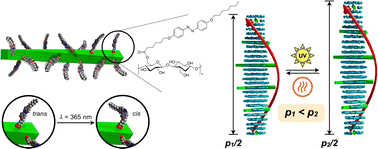
J. Mater. Chem. C, 2022,10, 18120-18126
https://doi.org/10.1039/D2TC04444G
Carrier transport characteristics of glass-forming chiral liquid crystalline dimers based on oligo(phenylenevinylene) units
We synthesized chiral dimeric chiral nematic (N*) liquid crystals bearing tri(p-phenylene vinylene) units and studied the carrier transport characteristics as well as the circularly polarized fluorescence in the N* phase of the liquid crystals.

Mater. Adv., 2022,3, 8428-8437
https://doi.org/10.1039/D2MA00899H
Polymer-grafted ZnO nanorods enhance optical nonlinearity of oligothiophene-doped liquid crystals
The photoinduced molecular reorientation of nonlinear optical materials is a promising approach to cause the nonlinear optical effect used for developing next-generation self-modulating and optical switching devices.
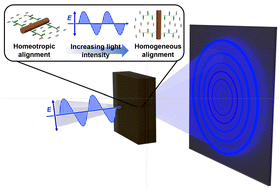
Mater. Adv., 2022,3, 7531-7537
https://doi.org/10.1039/D2MA00774F
Synthesis, self-assembly and optical properties of some rigid π-bridged triphenylene dimers
π-Conjugated liquid-crystalline dimers consisting of two triphenylene mesogens connected through a rigid molecular bridge have been synthesized. Mesophases, gels and optical properties have been investigated as a function of the bridge nature.
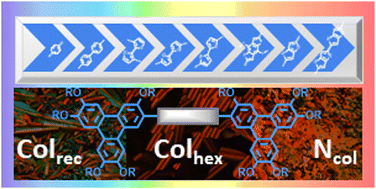
J. Mater. Chem. C, 2022,10, 14453-14470
https://doi.org/10.1039/D2TC02441A
Building a DC electric field-driven wheat leaf-like surface pattern with a cholesteric liquid crystal fluoropolymer for directional droplet manipulation
A wheat leaf-like surface pattern emerged above the solid coating of fluorinated cholesteric liquid crystal polymer under actuation of one-side DC electric field, to trigger directional droplet motion for precise and low-energy droplet manipulation.

Mater. Adv., 2022,3, 7219-7227
https://doi.org/10.1039/D2MA00796G
Luminescent assemblies of pyrene-containing bent-core mesogens: liquid crystals, π-gels and nanotubes
Bent-core and pyrene building blocks are revealed as a synergistic and versatile ‘tandem’ for the chemistry of luminescent supramolecular materials, guiding towards highly emissive liquid crystals, organogels and nanotubular systems, just by using the same molecule.
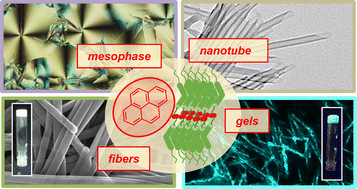
J. Mater. Chem. C, 2022,10, 12012-12021
https://doi.org/10.1039/D2TC02546A
Triphenylene-ethylammonium tetrachlorometallate salts: multicolumnar mesophases, thermochromism and Langmuir films
This study reports mesomorphic triphenylene-ethylammonium salts containing [MCl4]2− (M = Cu, Ni, Co, Mn) as counterion. The [NiCl4]2− group leads to combine mesomorphism, paramagnetism and thermochromism in the system.
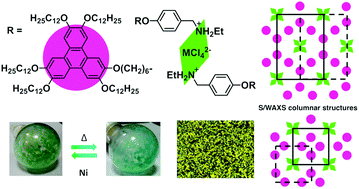
J. Mater. Chem. C, 2022,10, 9222-9231
https://doi.org/10.1039/D2TC01100J
Paramagnetic supramolecular mesogens: A new paradigm in self-assembled magnetic materials
Sterically crowded, shape-persistent star mesogens with three oligophenylenevinylene arms provide free space in which Blatter radical guests are incorporated by covalent bonds (esters) or supramolecular interactions (hydrogen bonds).
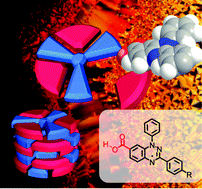
J. Mater. Chem. C, 2022,10, 8728-8739
https://doi.org/10.1039/D2TC00015F
Molecular clustering behaviour in the cybotactic nematic phase of a spin-labelled liquid crystal
A newly synthesised liquid crystalline nitroxide radical with a terminal trifluoromethyl group exhibits a cybotactic nematic phase. EPR spectroscopy of the spin-labelled LC implies that molecules move into and out of the cybotactic clusters.
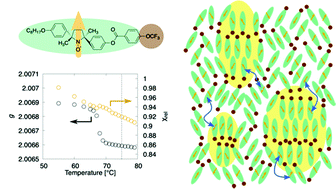
J. Mater. Chem. C, 2022,10, 6621-6627
https://doi.org/10.1039/D2TC00626J
Engineering mesophase stability and structure via incorporation of cyclic terminal groups
The installation of an aliphatic ring at the end of the alkyl chain for a family of 4-alkoxy-4′-cyanobiphenyl liquid crystals is shown to enhance clearing points and promotes the formation of smectic phases, relative to the linear parent materials.

J. Mater. Chem. C, 2022,10, 5934-5943
https://doi.org/10.1039/D1TC05954H
Fluorinated triphenylenes and a path to short tailed discotic liquid crystals: synthesis, structure and transport properties
We present a versatile synthesis method capable of creating triphenylene discotic liquids with enhanced control of the number and type of tails. The compounds obtained from this method include a discotic liquid crystal with unusually short methoxy tails.

Mater. Adv., 2022,3, 534-546
https://doi.org/10.1039/D1MA00606A
An unusual self-assembling columnar mesogen prepared by tethering a planar naphthalenediimide acceptor to bent phenothiazine donors
Tethering of two shape mismatched donors and acceptor leads to an unusual mesogen design.

Mater. Adv., 2022,3, 328-336
https://doi.org/10.1039/D1MA00452B
Electrically driven formation and dynamics of swallow-tail solitons in smectic A liquid crystals
Multi-dimensional particle-like solitons are formed in a smectic A liquid crystal driven by electric fields. The solitons are localized deformations of smectic layers and travel perpendicular to the smectic layers with a constant speed.
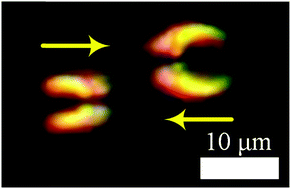
Mater. Adv., 2021,2, 4752-4761
https://doi.org/10.1039/D1MA00356A
Extraordinary magnetic field effects on the LC phases of homochiral and racemic 4-cyanoresorcinol-based diamagnetic bent-core mesogens
A huge effect of a magnetic field on the layer spacing of smectic and polar smectic liquid crystalline phases of a diamagnetic bent-core mesogen is reported, which is opposite for the uniformly chiral compound and its racemic mixture.
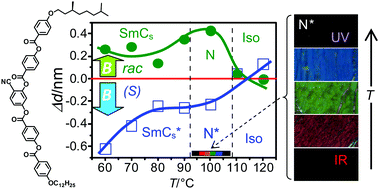
J. Mater. Chem. C, 2021,9, 1895-1910
https://doi.org/10.1039/D0TC05355D
Distinct twist-bend nematic phase behaviors associated with the ester-linkage direction of thioether-linked liquid crystal dimers
Two homologous series of thioether-linked liquid crystal dimers with oppositely directed esters, viz. CBCOOnSCB and CBOCOnSCB, exhibit largely different helical pitches in the NTB phase, which are ascribed to their molecular bend or biaxiality.

Mater. Adv., 2021,2, 261-272
https://doi.org/10.1039/D0MA00746C
Study of ferro- and anti-ferroelectric polar order in mesophases exhibited by bent-core mesogens
Ferroelectric nature in the NCybC phase and anti-ferroelectric nature in the SmC(I) and SmC(II) phases.

Mater. Adv., 2020,1, 3545-3555
https://doi.org/10.1039/D0MA00678E
Supramolecular liquid crystals exhibiting a chiral twist-bend nematic phase
The characterisation of a selection of novel, chiral supramolecular liquid crystals formed by hydrogen-bonding is reported; these are the first examples of the chiral twist-bend nematic phase (N*TB) induced by H-bonding through molecular recognition.

Mater. Adv., 2020,1, 1622-1630
https://doi.org/10.1039/D0MA00302F